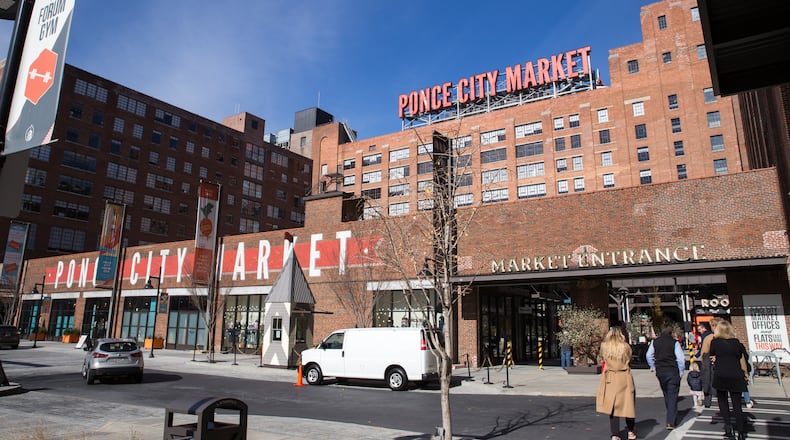Editor’s note: This story has been updated to include comment from the developer.
The developer of Ponce City Market is seeking millions of dollars in tax breaks for a second phase of the popular Beltline attraction.
The Development Authority of Fulton County is expected to consider an $8 million property tax break Tuesday for Jamestown Properties, which has proposed a $175 million expansion of the mixed-use project in a historic former Sears warehouse.
The proposal comes as the agency remains under scrutiny for generous incentives awarded in recent years in some of the Fulton County’s hottest neighborhoods.
An Atlanta Journal-Constitution investigation earlier this year found DAFC provided preliminary or final approval for more than $328 million in tax breaks since 2018. Critics say the awards were often made in exchange for few public benefits or were granted to projects in fast-growing areas like the Beltline or Midtown.
Jamestown has proposed a 163-unit apartment tower on an existing parking structure, an 85,000-square-foot timber-framed office building and about 23,000 square feet of new retail space on the North Avenue side of the complex. The second phase also includes plans for a “hospitality living tower,” essentially a 405-unit residential high-rise with hotel-like services for short-term and extended stays.
Among the public benefits are 16 apartments with subsidized rents reserved for people making 60% of the area median income, or about $52,000 for a family of four. That threshold of affordable housing is a requirement under the city’s inclusionary zoning.
Another eight units would be set aside as affordable for people who make 120% of the area median income, or about $103,000 for a four-member family, a DAFC fact sheet states.
Julian Bene, a frequent critic of DAFC and a former member of Invest Atlanta, the city’s economic development agency, called the Ponce City Market proposal “Exhibit A for a tax break that should be turned down.”
“It’s in the hottest market in town,” Bene said. Thousands of apartments have been built along the Beltline in recent years, and an office tower complex at 725 Ponce de Leon Avenue, next door to Ponce City Market, and which received a similar incentive, reportedly sold for one of the highest prices per square foot for a commercial property in Atlanta’s history.
“It’s time we focus relief in the blighted areas that really need it,” Bene said.
In a fact sheet published on its website, DAFC said the Ponce City Market site includes about $6.7 million in “extraordinary costs” for development, including topographical challenges, environmental remediation and $1 million to tie the project into Glen Iris Drive and the Beltline.
Jamestown did not immediately respond to an email and phone message requesting comment.
In a statement sent late Monday night, Jamestown touted the 5,200 jobs Ponce City Market brought to the neighborhood so far and said another 550 would be created as part of the second phase. The project, the statement said has generated $1 billion in economic value to the city and county and the second phase will create a net gain in tax revenues.
The company said some of the units leased in the “hospitality living building” would be “priced at a 15% discount to the submarket in an effort to create more attainable housing in the neighborhood.”
Jamestown said the company will create new minority and female-owned business opportunities for future tenants and workers who live in the community during second phase construction. Jamestown also plans to commit $1 million to a “Legacy Resident Retention Program and a to-be-formed DAFC Trust.”
“We look forward to continuing the conversation with DAFC and to creating an outcome that allows for continued job creation, additional job training programs for neighborhood residents, new affordable and attainable housing with deeper and broader levels of affordability, and enhanced neighborhood connectivity through sustainable development,” Jamestown CEO Matt Bronfman said in the statement. “We appreciate DAFC’s commitment to the community and their consideration of our request to partner with them on what would be an innovative and unique investment in the immediate and sustainable expansion of the county’s tax base.”
Critics say the tax break, known as an abatement, flies in the face of how the Beltline was envisioned. That’s because the Beltline is supposed to pay for itself using future tax revenue generated by new development and appreciating property values.
When the city started the Beltline, it created a special zone known as a Tax Allocation District or TAD that’s designed to take long-term gains in property values triggered by new development and invest those dollars into the trail, parks, future transit and affordable housing.
Jamestown’s overhaul of the neglected former Sears warehouse attracted tech companies and wooed hundreds of millions of dollars in new development nearby.
The area surrounding the Eastside Trail is one of the city’s most popular destinations, but the development interest has also displaced long-time residents who could no longer afford to live there. The Beltline, meanwhile, has so far failed to live up to its promise of creating thousands of new units of affordable housing.
To date, the Beltline has preserved or created fewer than half of the 5,600 units of affordable housing promised within the TAD by 2030. Another 4,255 affordable units have been preserved or built within walking distance of the trails, Beltline officials say.
Jamestown was awarded historic tax credits as part of its revitalization of Ponce City Market. Fulton County property tax records show the complex was appraised by the county at $40 million in 2021, a fraction of the value it likely would fetch on the open market. The tax bill was about $242,000 in 2021, according to online records maintained by the Fulton County Tax Commissioner.
Atlanta City Council recently created a “special services district” that raised taxes on commercial properties and apartment buildings near the Beltline to make up for financial shortages in the Beltline TAD. One justification for the tax hike was to make up for development authority tax breaks.




